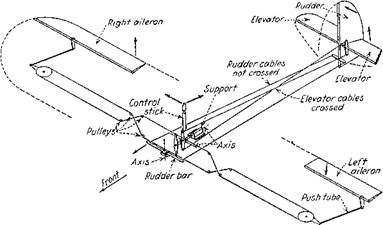Bleriot and Deperdussin Controls
Louis Bleriot devised what has become the standard stick and rudder cockpit controls for small airplanes. A central stick between the pilot’s legs is moved forward for nose down, aft for nose up, to the left for left wing down, and to the right for right wing down. The pilot’s feet rest on a rudder bar from the ends of which a pair of cables run straight back to the rudder horns. Thus left foot forward deflects the rudder to the left and turns the machine to the left (Figure 1.3). Bleriot fitted a nonrotatable wheel to the top of the control stick, perhaps to give the pilot a firmer grip for wing warping.
The Bleriot rudder pedal convention, now quite standard, is just the opposite of bicycle or “Flexible Flyer” sled steering, where operators turn the handlebars or hand grips in the direction of the desired turn. Igor Sikorsky thought that the Bleriot convention was backward. Sikorsky crossed the rudder wires on all of his airplanes, to make them steer like bicycles. He warned conventionally trained pilots not to try to fly these particular machines.
Before the war, the company Societe pour Avions Deperdussin (SPAD) produced a series of military airplanes and racers that were designed by Bechereau. These streamlined airplanes were fitted with Bleriot-style rudder bars and a vertical wheel that could be moved fore and aft for pitch and turned sideways for wing warp. The wheel’s increased mechanical
|
Figure 1.3 Diagrammatic sketch of a simple airplane control system. When the controls are moved as shown by arrows on the stick and rudder bar, the surfaces move as shown by the arrows. (From Chatfield, Taylor, and Ober, The Airplane and Its Engine, McGraw-Hill, 1936) |
advantage as compared with levers was needed to warp wings of increased torsional rigidity. The Deperdussin wheel is the ancestor of modern control yokes.












